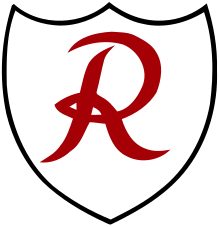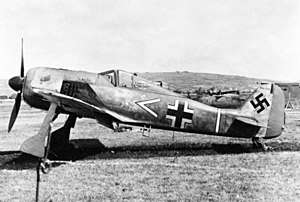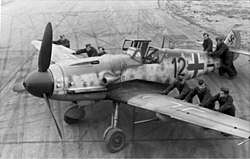''Jagdgeschwader'' 2
| Jagdgeschwader 2 | |
|---|---|
 Unit insignia | |
| Active | 1939–45 |
| Country |
|
| Branch |
|
| Type | Fighter Aircraft |
| Role | Air superiority |
| Size | Air Force Wing |
| Nickname(s) | Richthofengeschwader |
| Patron | Manfred von Richthofen |
| Commanders | |
| Notable commanders | Helmut Wick |
Jagdgeschwader 2 (JG 2) "Richthofen" was a German fighter wing during World War II.
Operational history
The unit was formed from parts of Jagdgeschwader 131 on 1 May 1939 in Döberitz and its first commander was Colonel Robert Ritter von Greim. At the outbreak of the war JG 2 based in the Berlin area under Luftgaukommando III. Stab and II. Gruppe were equipped with the Bf 109E and were located at Döberitz with 10.(N) Staffel flying the Bf 109D in Straussberg.

In preparation for Operation Barbarossa, the invasion of the Soviet Union in June 1941, most fighter units were transferred to Germany's eastern borders by May 1941 but JG 2 and JG 26 were left in north-west Europe. For the next two years, these formations were the main adversaries of Royal Air Force (RAF) daytime operations over Europe. The two wings maintained around 120 serviceable Bf 109Es and Fs to face the increasing number of RAF Fighter Command sweeps conducted to wear down the Luftwaffe in a war of attrition. One of the busiest days of combat on the Channel coast in 1941 took place on 21 June, with two RAF Circuses flown. II./JG 2 and JG 26 claimed ten and eight Spitfires shot down respectively although actual Spitfire losses were three.[1] On 23 June, 9 Staffel of JG 2 was almost destroyed by Fighter Command Spitfires.
On 23 July 1941, JG 2 claimed some 29 Spitfires, with a further 10 claims awarded to JG 26, against a real loss of 14. 23 July 1941 also saw JG 2 awarded their first three B-17 Fortresses shot down; the aircraft attacked were in fact Short Stirlings of 15 Squadron RAF Bomber Command, attacking the Scharnhorst in dock at La Pallice; one of the Stirlings being lost. [1] JG 2 claimed its 800th success in August; six members of JG 2 received the Iron Cross in 1941. On 12 August, Circuses No. 69 and 70 attacked Saint-Omer and Gosnay. JG 2 intercepted the formations and the commander, Major Walter Oesau, was credited with five Spitfires in ninety minutes; two other pilots claimed six additional aircraft, although only six Spitfires were lost that day.[1] The RAF flew three Circuses on 20 September and JG 2, in concert with its subordinated training Staffel 4./JFS 5, claimed 25 fighters shot down, against an actual loss of seven Spitfires.
On 11 February 1942, Gneisenau and Scharnhorst, made the Channel Dash in daylight towards the Northern German ports. Codenamed Unternehmen Zerberus (Operation Cerberus), JG 2 flew continuous air cover over the ships and claimed some 20 RAF aircraft without loss, during the British operations against the vessels.

1942 saw most of JG 2 convert to the Focke-Wulf 190 A, the exception being the 11. Staffel which was a "high altitude" squadron. It experimented with pressurized cabins and other technical refinements. JG 2 continued to operate in occupied France from Brest to the Somme, while JG 26 covered Northern France and Belgium. By March II./JG2 was operational in Théville and Morlaix and at the end of April I./JG 2 was operational in Maupertus, Morlaix and St. Brieuc flying the Fw 190 A-2.
In November 1941, Jafü 2 and Jafü 3 were ordered to allocate one squadron from each of their subordinate fighter Geschwader as Jabo (fighter-bomber) squadrons. This was to renew fighter-bomber activity against Britain and coastal traffic in the Channel. The Jabo were equipped with the Bf 109F-4B fitted with a fuselage rack for a SC250 bomb or four SC-50 bombs. Formed in March 1942, by June, 10 Staffel, JG 2s Bf 109 F-4B equipped Jabostaffel had claimed some 20 Allied merchant ships sunk, totalling 630,000 tons. In April 1943 10. JG 2 became part of IV./Schnellkampfgeschwader 10 (SKG 10).
On 19 August 1942 Allied forces made their first large Commando–style raid (the Dieppe raid) into continental Europe. JG 2 flew 430 sorties, losing 14 aircraft (8 pilots killed) and claiming 59 Allied aircraft shot down. By late 1942, JG 2 was in the forefront of the battle against the increasing weight of United States Army Air Forces (USAAF) Eighth Air Force daylight bombing. Gruppenkommandeur of II./JG 2, Major Egon Mayer, was central in devising 'head-on' attacks against the B-17 Flying Fortress that became standard practice in the Jagdwaffe.
Western Europe

In spring 1943, I./JG 2 led by Walter Oesau, moved to Triqueville airfield. Wing Commander Alan Deere planned an attack on the unit to provoke a confrontation. The plan involved a low-level approach by Deere and No. 403 Squadron to catch the FW 190s as they were taxiing for take-off. No. 611 Squadron was to attack the site and the No. 341 (Free French) Squadron were to patrol at 3,000 ft (910 m) south of the airfield, to guard against a counter from other elements of I./JG 2 at Évreux. No. 403 Squadron were spotted before the attack was launched and JG 2 aircraft reacted immediately by dispersing at low level immediately after take off. Deere fired on the hangar buildings before pursuing the JG 2 aircraft. Elements from Évreux joined in and a dogfight took place between evenly matched formations. The RAF squadrons left due to low fuel, 611 claiming two JG 2 shot down. I./JG 2 from Évreux claimed two Spitfires of 341 Squadron.[2]
Successful USAAF operations over Germany led to many novice and replacement pilots being killed through the first half of 1944; more importantly, the experienced pilots were also being lost. JG 2's commander and 102-kill ace Egon Mayer was shot down and killed in March 1944. One month later his successor Major Kurt Ubben was also killed by US fighters.
JG 2 was the main Luftwaffe unit to see action against Allied Air Forces during the D-day landings on 6 June 1944. Stationed at Cormeilles-en-Vexin 60 kilometres from the coast, I./JG 2 was one of the nearest fighter units to the Allied beachheads. JG 2 commander Major Bühlingen shot down a P-47 Thunderbolt over the Orne before the unit became embroiled in a dogfight with RAF Typhoons near Caen. Six were claimed, and JG 2 claimed 18 kills for the day without loss (Total Luftwaffe claims were 24 shot down). The superiority of the Allied forces soon took effect, with veteran pilots being lost in combat.
Towards the year’s end JG 2 received the first examples of the Fw 190D-9 'Dora'. Stab and III. Gruppe were first to convert and before the end of 1944 JG 2 was operating from near Frankfurt.
Unternehmen Bodenplatte was a mass fighter attack against the Allied airfields in the Low Countries and France on New Years Day 1945. It was hoped it would help regain temporary aerial superiority for the new German offensive through the Ardennes, but instead it delivered crippling losses to the Luftwaffe. Numerically, of all the fighter units JG 2 suffered most in this poorly conceived operation, suffering 37 pilots killed and nearly 40% losses. It took several weeks for JG 2 to regain operational status.
As the end of war drew near, all units of JG 2 were equipped with Fw 190D-9 'Dora'. During winter and spring JG 2 moved from the Rhine area into Bavaria. Following the German surrender, the wing was formally disbanded near Munich on 7 May 1945.
Commanding officers
- Major - Dipl.-Ing. Johann Raithel 1 April 1936 – 8.June 1936
- Oberst - Gerd von Massow, 9 June 1936 – 31 March 1940
- Oberst - Harry von Bülow-Bothkamp, 1 April 1940 – 2 September 1940
- Major - Wolfgang Schellmann, 2 September 1940 – 20 October 1940
- Major - Helmut Wick, 20 October 1940 – 28 November 1940 (MIA)
- Hauptmann - Karl-Heinz Greisert, 28 November 1940 – 16 February 1941
- Major - Wilhelm Balthasar, 16 February 1941 – 3 July 1941
- Oberstleutnant - Walter Oesau, 4 July 1941 – 1 July 1943
- Major - Egon Mayer, 1 July 1943 – 2 March 1944 (KIA)
- Major - Kurt Ubben, 2 March 1944 – 27 April 1944 (KIA)
- Oberstleutnant - Kurt Bühligen, 28 April 1944 – 8 May 1945
References
- 1 2 3 "In the Skies of France: The History of JG 2 Richthofen" (Vol. II: 1941). Mombeek and Roba
- ↑ Holmes & Dibbs 2000, pp. 78-79.
Further reading
- Arthy, Andrew; Jessen, Morten (2004). The Focke-Wulf 190 in North Africa. Classic. ISBN 978-1-903223-45-1.
- Franks, Norman (1979). The Greatest Air Battle: Dieppe, 19 August 1942. London: William Kimber Books. ISBN 978-0-7183-0396-9.
- Holmes, Tony; Dibbs, John (2000). Spitfire: Flying Legend. Oxford: Osprey. p. 192. ISBN 978-1-84603-190-8.
- Murray, Williamson (1996). Luftwaffe- Strategy for Defeat 1933–45. London: Brassey's. ISBN 978-1-57488-125-7.